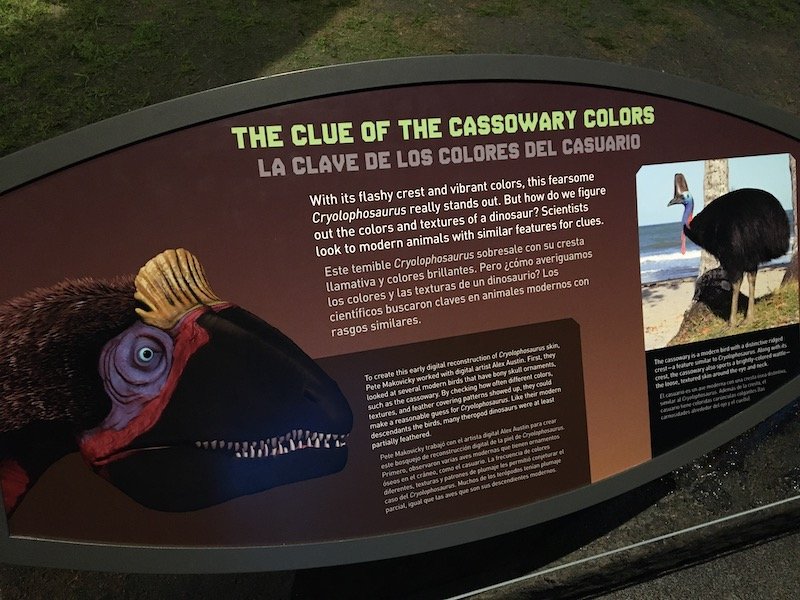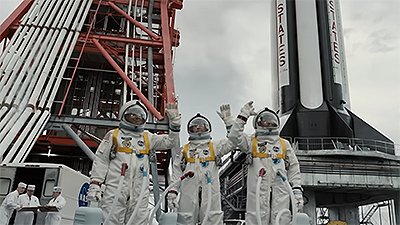
Dinosaurs of Antarctica in OMNIMAX Review
A beautiful film presents evolutionary propaganda.
Setting the Stage
Going to this film, I was excited. However, after I viewed the trailer for the first time, my heart was saddened. As you’ll see throughout this article, this film was saturated with evolutionary storytelling and progressive agenda. Starting off with a look at a lush, warm, and very active jungle dotted with Glossopteris trees, we are quickly informed that what we are viewing is actually Antarctica . . . 190 million years ago in the Jurassic period. We are then greeted by the sight of a river, and two tritylodonts (small mink-like mammals) emerge from the forest to get a drink. They are quickly interrupted and scared off by a group of Antarctic pterosaurs that are very similar in appearance to the English pterosaur Dimorphodon. The pterosaurs and tritylodonts are creatures that lived alongside the dinosaurs found in Antarctica.
At this point in the film, we begin a trend that carries through the rest of the film. We jump back to modern Antarctica where we are greeted by a very different landscape. Frozen, and barren, the Antarctica we see today is very different from what we were shown only moments ago. The film explains that way back in the Jurassic period, Antarctica was part of a supercontinent called Gondwana. Eventually over the millennia, Antarctica split off from Gondwana and began its slow and gradual move to where it is currently located. As it moved south, the forests died, and the continent began to build up its massive ice layers that we see and observe today.
So what does all this have to do with dinosaurs? Well, only a portion of the film is dedicated to dinosaurs, and an even smaller percentage deals with actual facts about these animals. The majority of the film is concerned with the story of Antarctica’s supposed evolution-filled past.
To keep this simple, we will split the film into two parts and briefly review them separately before concluding with some final thoughts. The first portion uses modern CGI to look back at what the “prehistoric” Antarctica may have looked like, and the second portion follows a team of scientists on their expedition to Antarctica in search of more evidence of the frozen continent’s “not-so-frozen” past.
As we return to ancient Antarctica, we come across a small herd of Glacialisauruses grazing in a fern meadow. However, things quickly get busy as a 25-foot-long theropod dinosaur called Cryolophosaurus rushes out of the tree line and begins chasing the smaller herbivores. They run to a river to escape, and all hope seems lost as the predator catches up. But just as you think one of the “glacies” is going to be killed, a mysterious call distracts the theropod. This turns out to be a female Cryolophosaurus. While the male “cryo” is distracted, the small herd of prosauropods makes a hasty escape. Aside from a few short clips here and there, this the last we see of these large dinosaurs, as we are then transported to the late Permian period, a time just before what evolutionary scientists refer to as the “Great Dying,” the mass extinction at the end of the Permian period. Here we view lystrosaurs (a common type of synapsid), and an unnamed, but very large amphibian. We are then taken further and further along the evolutionary timeline, encountering more and more creatures along the way, including more lystrosaurs, a giant salamander called Antarctosuchus, a reptile named Prolacerta, ancient cockroaches, and more. Finally, we are briefly brought back into the “age of the dinosaurs” before quickly being told of the rise and fall of reptiles and the slow takeover by mammals as they became the dominant animals on the earth after living for millions of years in the shadows of the dinosaurs. However, according to the film, there is no need for remorse because the ancestors of the dinosaurs are still with us today, and in fact many of them call the icy continent their home. That’s right, according to one plaque in the Dinosaurs of Antarctica exhibit that accompanies the film, penguins are modern Antarctic dinosaurs.

Plaque in the Dinosaurs of Antarctica exhibit that claims penguins are modern Antarctic dinosaurs.
Now, before we address some of the issues with the thematic portion of the film, let’s take a look at the scientific side of the film. As stated before, early on in the movie we begin to jump back and forth between following a modern team of Antarctic scientists on their quest for truth and the animated scenes we have looked at already.
A team of scientists comprised of a paleobotanist, vertebrate paleontologist, fossil preparator, and a geologist are on an expedition to the frozen south to look for new evidence of what the ancient Antarctic landscape looked like and what types of creatures called it home. Flying from the southern island of New Zealand, the team arrives in McMurdo Station, described by the narrator as a “science city.” This outpost is a United States research station located on Ross Island and is the largest research station on the Antarctic continent. From there, they take a short two-hour flight to a smaller research station farther inland. They remain in “Tent City” for several months. At this small station, helicopters are used to transport the teams of researchers to and from their field sites where they collect dozens of both plant and animal fossils, including a large lystrosaur fossil. They then load up their gear and the fossils they found and head back north. Back at the lab, the scientists will work countless hours to uncover the truth about this frozen desert. Or rather, what they think is truth.
Fact vs Fiction
Though we as Christians know that there are no “versions” of the truth—there is simply truth and non-truth—Scripture has much to say about truth. John 8:32 says, “And you will know the truth, and the truth will set you free.” Proverbs 30:5 explains that “Every word of God proves true; he is a shield to those who take refuge in him” (emphasis mine).
Though we as Christians know that there are no “versions” of the truth—there is simply truth and non-truth.
As I mentioned at the beginning, my heart hurt after watching the film’s trailer. But why? Why would I be disheartened by an innocent film about dinosaurs? Because in truth, this is no innocent film about dinosaurs. In fact, dinosaurs are a very small portion of what is discussed in this program. Most of the movie is straightforward evolutionary storytelling, driven by a worldview that rejects God and his Word and what he says about creation and the global flood. What hurts my heart is the knowledge that thousands of individuals, young and old, including many kids will view this film and see what it says about dinosaurs, deep time, and evolution, and blindly accept it as scientific fact. Countless boys and girls, men and women are being led astray by this anti-God “scientific” presentation. As a dinosaur educator, it is very hard to see these remarkable animals used to point people to the story of evolution rather than the glory of their Creator.
So is it worth watching? Is it worth your time? Let’s dig deeper! Like many secular programs and institutions, it is able to be viewed and enjoyed, and we can actually learn a lot from it if we learn and understand the truth founded in God’s Word and how to weed out the facts from fiction.
Throughout the film, there were three things that stood out to me. The assumed acceptance of long ages and evolution by the viewer, the assumed acceptance of dinosaur-to-bird evolution, and the unsurprising tie-in to modern climate change. So as Christians, how do we respond to these issues—all three of which directly contradict God’s Word?
Let’s start with deep time and evolution. The worldview held by the majority of the scientific community is that the earth is billions of years old and the universe is even older. Within this timeline, humanity is but an insignificant speck. Life began on earth approximately 3.4 billion years ago, and over millions of years it evolved from a “simple” single-celled organism into progressively more complex creatures until finally . . . here you are. “From goo to you, by way of the zoo” I believe is the “technical” terminology. But if we take a step back, does this really make sense? Everything came from nothing? Of course not! In fact, one of the major and most basic tenets of science is that life cannot come from nonlife. Scripture tells us in Genesis chapter one that God created the heavens and the earth in six, twenty-four-hour days and that every living thing reproduces only after its own kind. This information, along with the history from Adam to Abraham found in the following chapters, leaves no room for millions of years or evolution.
What about dino-birds? Do we really eat Kentucky Fried Dinosaur? This question is easily answered if we once again visit Genesis chapter one. Verses 20–25 outline the supernatural creation by God of sea and flying creatures on day five and the creation of land creatures on day six. Not only do these verses repeatedly affirm that each kind only produces more of that kind (cats cannot produce anything other than more cats), but they also place the birds (most of which are flying creatures) before the dinosaurs (which are land animals) that they supposedly evolved from. Any logical person can see how this simply doesn’t make sense even if you try to mix man’s ideas of millions of years and evolution into the Bible (like many compromising Christians unfortunately do). “Every word of God proves true” (Proverbs 30:5).
But what about the Cryolophosaurus? It was covered in fuzz, or early feathers, right? False. Though the mascot for the film is given a cassowary-inspired array of colors and sports a thick covering of “dino-fuzz,” there is no evidence for this idea. While we do find the fossilized skin of many dinosaurs (all of which are clearly reptilian), no such finds have been made regarding Cryolophosaurus. There is no logical reason to think that this animal had any type of covering other than tough, scaly skin, just like all other reptiles. Though one might argue—maybe it needed them to stay warm. There are two things we can discuss on this. First, the claim throughout the entire film is that Antarctica was warm when dinosaurs were on it, so there is no need for extra warmth. Secondly, if it actually did need extra warmth, then why did the Glacialisauruses seen alongside it not sport this coat as well? They were nearly as large, so if evolution were true, why would these animals not have evolved “dino-fuzz” too? The evolutionary scientists are inconsistent in their presentation of these animals. The “cryo” is only “believed” by evolutionists to have been fluffy because it is “believed” to be related to other dinosaurs which are themselves “believed” to have been fluffy. I could go on for millions of years . . .

Cryolophosaurus exhibit plaque.
While we do need to care for God’s creation and be good stewards of it (Genesis 1:26), we do not need to be concerned or afraid of destroying it.
Lastly, what does climate change have to do with dinosaurs? Quite a bit actually. Ancient climate change, caused by the global flood is likely one of the major contributing factors that caused the gradual (not sudden) extinction of all dinosaurs in the centuries following the flood. However, the scientists in this film are concerned with understanding climate change of the past to better prepare for and be able to tackle man-caused climate change today. But as Christians, should we be concerned about a “global climate crisis” or causing our own extinction? No. The Bible tells us in Genesis 8:22, recording God’s words to Noah after the flood, that “While the earth remains, seedtime and harvest, cold and heat, summer and winter, day and night, shall not cease.” Until the day of judgment comes, all things will continue on. While we do need to care for God’s creation and be good stewards of it (Genesis 1:26), we do not need to be concerned or afraid of destroying it.
Final Thoughts
I present this question once again. Is it worth watching? Is it worth your time? That is up to you. I believe that as long as we are grounded firmly in our faith and are prepared to discuss with our family and friends—especially young people—what is fact and what is fiction, Dinosaurs of Antarctica can be a fun and unique experience for the whole family.
Recommended Resources

Answers in Genesis is an apologetics ministry, dedicated to helping Christians defend their faith and proclaim the good news of Jesus Christ.
- Customer Service 800.778.3390
- Available Monday–Friday | 9 AM–5 PM ET
- © 2025 Answers in Genesis




